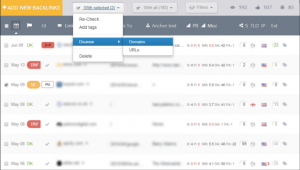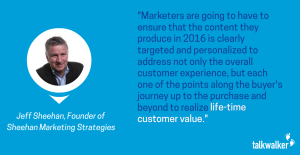Every smart brand knows the value of analyzing competitors. To really nail your own business strategy, it pays to have a sharp eye on your neighbors’.
You can study their social media strategy, how they work with influencers, and their broader PR approach. Or you can get super precise and focus on the way they deal with customer complaints.
By doing this, you’ll understand whether your own plan is sound or if you need to make some tweaks.
The good news is, once you’re up and running, it’s a piece of cake. Staying on top of the competition only takes five minutes a day.
So it’s time to put a plan in place, and we’re here to help. These are the four key steps to learn from your competitors and take a few shortcuts.
Let’s get down to business.
1. Figure out which competitors you’ll analyze
I can already hear your response – it’s obvious who our competitors are. They’re the other companies doing what we do, making what we make. We’re Coke; they’re Pepsi. We’re Nike; they’re Adidas.
But you need to think not only about direct competitors – those brands whose products look just like yours – but also those chasing your same market.
There are three main categories of competitors:
- Direct competitors – These brands offer essentially the same product as you.
- Indirect competitors – These have different products, but target the same need.
- “Available spend” or replacement competitors – These compete for the same budget as your brand, even if the product is different.
For example: a lipstick brand competes with other lipsticks (direct), lip balm and lip gloss producers (indirect), as well as eyeliner, eyeshadow, and mascara companies (replacements).
To understand your market, you need to watch what all types of competitors are doing. It’s obvious that lipstick brands eat into each other’s market, but what if buyers decide they don’t need lipstick if their eyes steal the show? That’s why it’s important to consider replacement competitors too.
How many companies you monitor will depend on your resources. With a little imagination, your list could be endless. But you don’t have the time to monitor every competitor, so it’s important to prioritize which ones matter most. There are a few different factors to consider, so let’s take a look at them.
How to choose the competitors you’ll monitor
Make a list of competitors including direct, indirect, and replacement examples. Choose a handful from each category, so that you have a range of brands to monitor. You’ll receive insights into close opponents, but also your wider industry.
If you’re confident you know your market inside-out, you could focus exclusively on direct competitors. You risk missing out on information about your broader industry, but you’ll have a laser focus.
Now you should create a schedule for monitoring that’ll give each competitor the necessary attention.
Break it down daily, weekly, and monthly: Monitor your top three (direct) competitors every day. Track your indirect competitors once per week. Finally, check in on your “available spend” competitors once a month to keep a wider view on the marketplace.
Adjust this schedule to suit the time you have available. What’s important is that you collect data about competitors to keep well informed.
But what kinds of data are we even talking about? It’s time for step two.
2. Choose what you want to monitor
So what business information are you looking to find? How much competitors spend on office space? That’ll be tricky, and it’s not very useful. Their employees’ tax returns and dental records? That’s creepy and it sounds illegal.
What is available is information about their marketing and social media presence. The whole point of these things is that they’re public, after all.
The great thing about competitive monitoring is it pulls in all this data without you having to go searching. Your monitoring tools automatically collect a range of valuable information. This includes insights into:
Their marketing campaigns
This should be a major priority. One benefit of real-time competitor analysis is you’ll know when they launch new campaigns and products. It goes without saying that if a competitor produces something exciting or innovative, you need to know right away.
Your analysis will also tell you just how successful these new campaigns were. Monitoring tools give you the reach of a campaign and how many people are sharing the content on social media and forums.
Finally, you’ll be able to track the response to these campaigns online. Sentiment analysis will give you a good overall idea of whether people liked a campaign, or you can look more closely at individual responses.
Their social media presence
You want to see where they’re the most active, and what their social media marketing consists of. That means tracking the content and themes of their posts, as well as where they’re posting them.
Some of this won’t surprise you. They’re bound to be on Twitter, Facebook, and probably elsewhere. Take a look at the images they use, the tone of their messages, and whether it seems to be working. If they’re seeing good engagement, you may want to take a similar approach.
They may also see success on social networks you’d never considered. Some companies have a strong presence on Reddit, for example, and yet many of us don’t think of it as a suitable marketing space. If a competitor succeeds on Reddit, you need to think seriously about doing the same.
Their customer service
We’re mainly focused on social media here. Since these are public spaces, a company’s customer service there can reach more than the individual they respond to. In fact, particularly sharp responses have been known to go viral.
To make sure your own customer service is up to scratch, take a look at what others are doing. Check the tone of their messages, and see how they’re received by customers. Be ready to share these with your own customer support staff, to make sure your service is as good as (or better than) the competition.
Their content
This includes their website and other content, like their blog. Watch for major website changes like a new design or restructure. Since many customers’ first impression of each company will be its homepage, you need to make sure that yours is the clear winner.
If you’re focused on content marketing, your blog will be your pride and joy. Watch what they’re producing, and ensure your own content is even better. Monitoring will also show you where their content is being shared, and how they’re sharing it.
Influencers talking about them
Influencer marketing is now a staple strategy for successful businesses. Chances are your competition has reached out to influential people to help spread the word. These could be paid agreements (like endorsements), a favor for a favor, or simply because they like the product.
These could be reviewers, industry bloggers, or just fans with social media accounts. By finding these people, you can make sure they’re aware of your own offerings. They may be happy to talk about you once you’ve put yourself on their radar.
Decide which of these elements are most important to track based on your own marketing strategy.
3. Choose the tools you’ll use
You may be planning to do all this analysis with just your own fabulous mind and a new browser window. Stop right there.
There’s too much to monitor for you to possibly do this without help. Besides, your time is more valuable than a computer’s, so let it do the hard work. There are a range of different tools you could choose. Pick something that works for you, and collects the right data.
Here are a few suggestions.
Web tracking tools
Want to see what’s being said about your competitors online? Of course you do! That’s why you’re reading this. Web tracking shows you where they’ve been discussed in the news, in reviews, and on forums. For this, you need a media monitoring tool like Mention.
The obvious web sources to monitor are major news and review sites. You’ll quickly get a sense of the kind of PR they’re doing. When you find stories about them in the news – especially success stories – ask yourself why your brand isn’t being featured. If you find a glowing review in an industry publication, find out what you need to do to be reviewed also.
Social listening tools
If you’re only interested in social media, you may want a tool just for that. The best media monitoring tools also cover social, so you’re able to achieve both goals.
If you’re only monitoring social media, Hootsuite is a good option. Tweetreach is also great if you’re focused on Twitter.
SEO tools
Everyone’s caught on to the importance of good SEO strategy by now. By its very nature, SEO is competitive. To be number one, you need to knock someone else down. To get ahead of your competitors, you need to see the keywords they’re targeting and backlinks they’re generating.
There are countless great tools for monitoring your competitors’ SEO strategy. Tools like SpyFu make it simple to figure out which keywords your competitors’ target. You enter a website URL and you see all the site’s organic search keywords, as well as what their top competitors rank for.
Majestic and Monitor Backlinks let you find sources that link to your competition. Majestic will also tell you their best-performing pages and LinkResearchTools alerts you when competitors gain new backlinks.
Figure out what you want to watch in your competitors, then select the tool(s) to match. Chances are you’ll want more than one anyway, so shop around a little.
For more help choosing the right monitoring tool, get our quick cheat sheet.
4. Pull the trigger
All you have left to do is actually get started. You’ve got a plan in place, so it’s time to put it into action.
Choose the competitors you want to monitor, the activities you’ll track, and get the best tool for the job. Set up alerts for your competitors and see what comes back.
You’re looking for information that’ll help you improve your own brand. By tracking your competitors’ strategies, you ensure your business is the best is can be.
But be flexible. Your plan will change as you modify your own strategy, or as new competitors enter the market. If you aren’t ready to adapt, you’re doomed to fail.
So get cracking!
Business & Finance Articles on Business 2 Community
(317)








